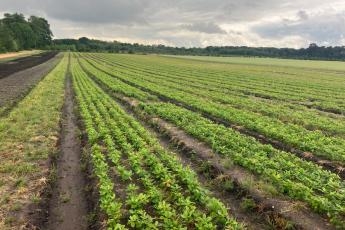Silk Wood Community Planting Project - A trip to Delamere Nursery
After introducing Oscar and his role (which is kindly funded by supporters of The Friends) a couple of months ago, he has been busy behind the scenes planning and making progress to get ready for the project to regenerate a part of Silk Wood with the help of the local community. Read on to find out about his trip to Delamere Nursery...
As the Project Manager for the Silk Wood Community Planting Project (SWCPP), my main role so far has been getting the project up and running in preparation for planting this autumn. Over 3 years, we hope to regenerate 5 hectares of Silk Wood which were devastated by ash dieback. These areas will become Westonbirt’s first Community Woodland, which will be designed, planted, managed, and monitored by community groups, schools and volunteers.

Recently, I had the exciting opportunity to visit Delamere Nursery, which was a significant milestone for the project. This nursery supplies over 4 million trees to Forestry England each year and is home to the largest tree-dedicated glasshouse in the UK. The nursery will be supplying most of the trees for the SWCPP, and so I went along to see how the trees were doing. There are two nurseries at Delamere, Lobslack (my first stop) and Abbots Moss.

I’ve planted a few trees but haven’t given much thought about how all the saplings I’ve handled started their lives. The tour started with a look at a machine, which at this time of year was not in operation, in which soil of some description goes in at one end, and the very familiar cell-grown shaped pugs come out the other. Generally, when buying saplings, you either get cell grown, which comes in a small plug of soil, or bare root, which, as the name suggests, has bare roots! It was interesting to hear about the struggles of reducing peat use in the plugs have caused, and how there is still a push to find suitable alternatives.

Adjacent to this room was the star of the show, the glass house. The sheer scale of tiny trees was hard to comprehend, trees are kept together in raised panels (racks) which were a hectare in size each. The first rack contained thousands of Douglas fir. Nursery workers were busy weeding at the far end of the rack, with what looked like a sea of green behind them. To think each of these saplings could reach maturity was mind-blowing. The distinctive smells of each species became apparent as we walked between the racks, scents of Sitka spruce, western red cedar and Scots pine filled the air.

Until recently, Lobslack Nursery has exclusively produced conifers. The SWCPP will be among the first planting schemes to receive broad leaves grown at the nursery. Outside the glass house, we saw small leaved lime and many oaks waiting to be deployed.
After lunch, we popped over to Abbots Moss Nursery. Here is where the bare root stock is produced. The saplings here are planted in fields in long, straight rows. An onlooker might be unable to distinguish the nursery from surrounding agricultural land, but getting up close you can see these fields were large expanses of tiny forests.
The nursery staff were very knowledgeable and gave me valuable advice on choosing the right trees based on their growth, adaptability to the local climate, and importance to biodiversity. It was great to see some of the trees that will one day tower over the community woodland. I will be eagerly awaiting our first delivery of trees from Delamere Nursery this autumn and cannot wait to see the project begin to come to life.

Community involvement is at the heart of this project. By engaging a wide range of groups, we hope to create a sense of shared ownership and pride for the woodland, as well as allow participants to learn about trees, woodland management, and heritage conservation along the way. If you would like to get involved, please get in contact with me at oscar.adams@forestryengland.uk
Finally, I want to express my gratitude to our generous supporters, whose contributions have made my role possible and have helped the project get up and running.
Look out for more updates about this incredible project later this year.
